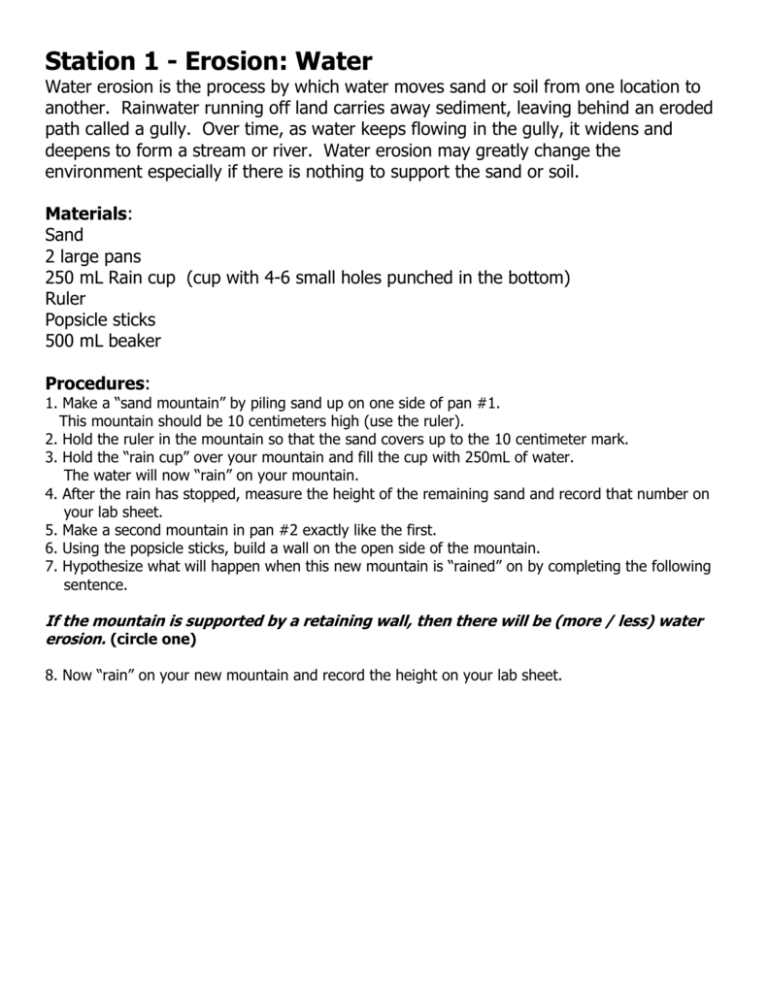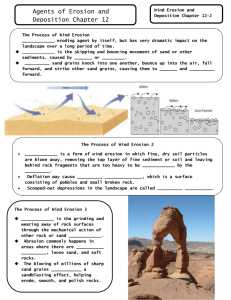Weathering, Erosion and Deposition
advertisement

Station 1 - Erosion: Water Water erosion is the process by which water moves sand or soil from one location to another. Rainwater running off land carries away sediment, leaving behind an eroded path called a gully. Over time, as water keeps flowing in the gully, it widens and deepens to form a stream or river. Water erosion may greatly change the environment especially if there is nothing to support the sand or soil. Materials: Sand 2 large pans 250 mL Rain cup (cup with 4-6 small holes punched in the bottom) Ruler Popsicle sticks 500 mL beaker Procedures: 1. Make a “sand mountain” by piling sand up on one side of pan #1. This mountain should be 10 centimeters high (use the ruler). 2. Hold the ruler in the mountain so that the sand covers up to the 10 centimeter mark. 3. Hold the “rain cup” over your mountain and fill the cup with 250mL of water. The water will now “rain” on your mountain. 4. After the rain has stopped, measure the height of the remaining sand and record that number on your lab sheet. 5. Make a second mountain in pan #2 exactly like the first. 6. Using the popsicle sticks, build a wall on the open side of the mountain. 7. Hypothesize what will happen when this new mountain is “rained” on by completing the following sentence. If the mountain is supported by a retaining wall, then there will be (more / less) water erosion. (circle one) 8. Now “rain” on your new mountain and record the height on your lab sheet. Station 2 - Erosion: Wind Fast-moving wind can carry sand and dust that weather the surfaces they strike. Wind erosion is greatest in dry area, such as deserts, where there is little water to hold soil particles together or trees and grasses to block the wind’s path. Materials: Sand Large pan Straw with a bend Small pebbles Safety goggles Procedures: 1. 2. 3. 4. 5. 6. Put on safety goggles. Make a small pile of sand (sand dune) in the middle of the pan. Using a straw, lightly blow over the sand. DO NOT blow so hard that sand leaves the pan! Observe the effects on the sand dune and record on your lab sheet Make a new sand dune in the middle of the pan. Place pebbles on the surface of the new hill, and hypothesize what will happen when you blow on the sand and pebbles by completing the following sentence: If pebbles are added to the surface of the sand, then (more / less) sand will blow away. (circle one) 7. Now lightly blow across the sand and pebbles. 8. Observe the effects on the sand dune and record on your lab sheet Station 3 - Erosion: Glacial Rivers and sheets of year-round ice called glaciers slowly move over land. As they travel, glaciers can move boulders the size of houses, as well as smaller sediments. Over time, the rocks and sediment carried by moving glaciers can carve or deepen valleys. The erosion caused by glaciers can be simulated using an ice cube, some sand, and a piece of modeling clay. Materials: Ice cube Clay Sand Gravel Procedures: 1. Use the clay to form a small mountain with the beginnings of a valley 2. Sketch the shape of your mountain with a front view on your lab sheet. 3. Place the ice cube at the top of the valley. Press the ice down firmly and move it down the valley 5 times. 4. Observe the effects of the “glacier” model on your lab sheet. 5. Place a small amount of sand and gravel in the valley. 6. Place the ice cube at the top of the valley again and let it set for about 1 minute. 7. Pick up the ice cube and look at the bottom. Describe your observations. 8. Place the ice cube back in the same position and move it down the valley 5 times. 9. Observe the effects of the “glacier” model on your lab sheet. 10. Sketch the shape of your mountain with a front view on your lab sheet. Station 4 - Deposition: When moving water, ice, wind, or gravity drops a load of Earth materials in a new place, it is called deposition. Materials: foil pan Catch pan or bucket under the end of the stream table Sand Water Funnel Procedures: 1. With the container elevated on one end, slowly add small amounts of water through a funnel to the upper end of the container. 2. Observe the effects of the water on the sand 3. Observe and describe what ends up in the “catch pan”








